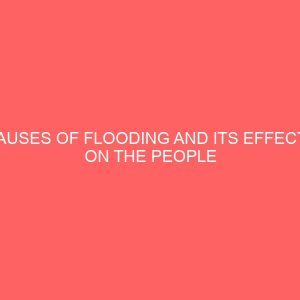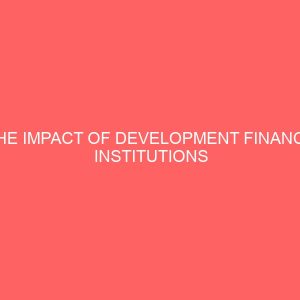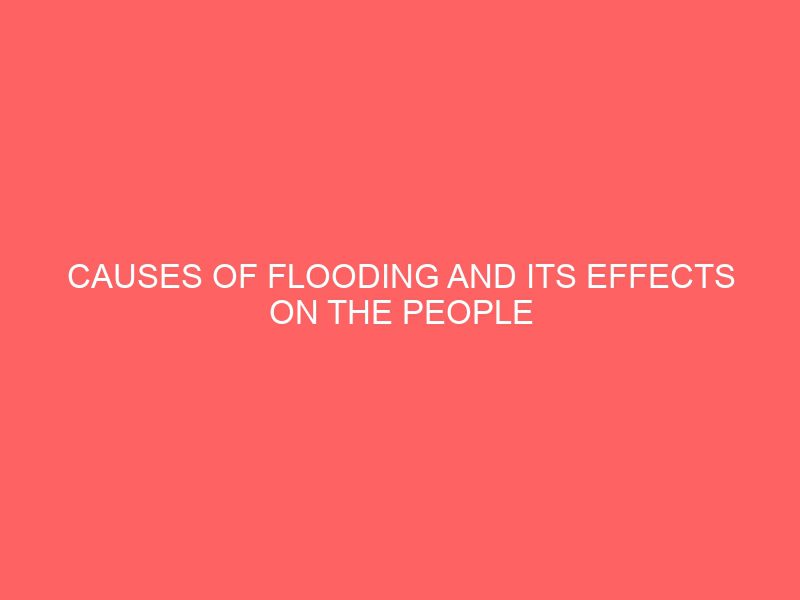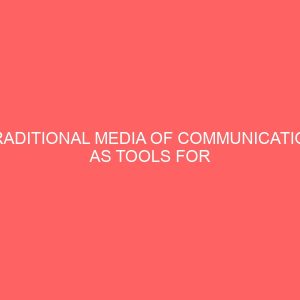Description
ABSTRACT
This project is the overview of the causes of flooding and its effects on the people of Northern Cross-River State. (A Case Study of Ikom Metropolis) the study was carried out to investigate the causes of flooding and its effect on the people of Ikom Metropolis and also analyze the flood control strategies so as to reduce the incidences in Ikom.
Chapter one discussed much of the properties damaged from natural disasters in Ikom Urban Area as caused by floods and some of the major environmental problems being caused by flooding such as direct inundation, land sliding, damaging of properties and household effects.
The literature reviews the origin and history of floods and also some causes and types of floods that exist as well as the effect of flooding in the environment.
The research designed and methodology reveals the population of study, the study area, sampling procedures, research designed as well as data analysis procedures, where the research make use of frequency distribution table for the analysis.
The data presentation, analysis and interpretation of result are deliberated in chapter four.
Discussion, conclusion and recommendation are discussed properly in chapter five.
Conclusively, this project work was carried out to help the people living in flood-plain and some of the recommendations were drawn down, that if they are strictly implemented, some of the problems caused by flooding will be minimized.
TABLE CONTENT
Title Page – – – – – – – – – i
Certification – – – – – – – – – ii
Dedication – – – – – – – – – iii
Acknowledgement – – – – – – – – iv
Abstract – – – – – – – – – v
Table of content – – – – – – – – vi
CHAPTER ONE
1.0 Introduction – – – – – – – – 1
1.1 Background of Study – – – – – – 2
1.2 Statement of Problem – – – – – – 2
1.3 Aims and Objectives – – – – – – 3
1.4 Significance of Study – – – – – – 3
1.5 Scope and Limitations – – – – – – 4
1.6 Research Questions – – – – – – 4
CHAPTER TWO
2.0 Literature Review – – – – – – – 5
2.1 History and Origins of Floods – – – – – 5
2.2 Cause of Floods – – – – – – – 6
2.3 Effects of Flood in the Environment – – – – 8
2.4 Techniques of Flood Control and Management – – 9
2.4.1 Flood ways – – – – – – – – 15
2.4.2 Greatest Amount of Flood Control Measure – – – 19
2.4.3 Economic Measures to Control Floods – – – 20
2.4.4 Flood Routing – – – – – – – 21
CHAPTER THREE
3.0 Research Design and Methodology – – – – 23
3.1 Study Area – – – – – – – – 23
3.2 Research Designed – – – – – – 23
3.3 Population of study – – – – – – 23
3.4 Sampling Procedure – – – – – – 24
3.4.1 Description of Sample – – – – – – 24
3.5 Data Analysis is procedure – – – – – 24
CHAPTER FOUR
4.0 Data Presentation/Analysis and interpretation – – -25
4.1 Data Presentation – – – – – – – -25
4.2 Data Analysis – – – – – – – -25
4.3 Data Interpretation – – – – – – -25
CHAPTER FIVE
5.0 Discussion, Conclusion/Recommendation – – – -35
5.1 Discussion – – – – – – – – -36
5.2 Conclusion – – – – – – – – -36
5.3 Recommendation – – – – – – – -36
Questionnaire – – – – – – – -37
References – – – – – – – – -39
CHAPTER ONE
1.0 Introduction
Flood can be referred to as a body of water that covers normally dry land. Flood were common long ago before human appeared. Even today: Most floods are independents out of influence and result from heavy run off due to intensive or persistence of rain, rapid melting of snow or destruction of vegetative covered by lightening induced fires. But human have contribute to the problem by ill conceived practices in lumbering, agriculture and industry.
Most floods are harmful, the physical hazards involve in Flood induce direct inundation, caring from river banks landslides or degradation, erosion of new channels, debris and mid flows and deposition of sediments.
Inundation may also result in loss of human life’s and destroy homes and household. Floods inundate vast tracts of cropped areas by carrying off the top soil, living the land barren, and bring epidemics like cholera and typhoid in the affected area carrying the banks, along flood plain channel undermines building, roads and others structures. Land slides in steep mountains, valley results from accelerated river erosion particularly on the outside of curves. New channel are often eroded when flood waters out top channel banks. The flood channel may cross build-up areas, destroying and washing out roads, rail roads, and utility lines.
Debris and mid flows result when flood waters, laden with sediments, Lose water through undergrounds seepage. The flow may full channels and spread over neighboring ground, penetrating and crushing building. However, floods only bring destruction, but some times the can be harmful.
1.1 Background of Study
The background of this study is to investigate the causes of flooding and its effects on the people of Ikom metropolis and also analyze flood control strategies so as to reduce the incidences in Ikom.
1.2 Statement of Problem
Much of the properties damaged from natural disasters in Ikom Urban area are cause by flood. This is due not to the frequency of floods, but the concentration of significant part of the population in the area susceptible to flooding. Some major environmental problems being caused by flooding include the following:
- Direct inundation (the overflowing or influx of water, especially over land):- This result in washing away habitation and losing of lives of people living in the area.
- Damaging of properties and household effect e.g. Automobile cattle’s and vegetations etc.
- The flooding problem in Ikom metropolis brings epidemics like cholera, dysentery and typhoid etc. in the affected area.
- Also, environmental problems like land sliding, erosion and deposition of sediments caused by flooding. Because of the above problems, the Ikom dwellers like the Yala, Nkam, Okum, Okonla Nkpans, Akam village and social development.
1.3 Aims and Objectives
The aim of this project is to investigate the cause and effects of flooding in Ikom Metropolis and also analyze the flood control strategies so as to reduce incidences in Ikom.
1.4 Significance of the Study
The research will help the researchers and the study population to understand better, the causes, effects as well as ways of controlling the flood.
It will also help to prevent further occurrences and destruction of properties will also be reduced.
Construction of flood control dams, which stored water generation of electric power electricity, is generated for industrial and commercial uses. The flood control measure suggested, such as flood walls and levees will help in keeping water off the land and across the roads, for easy transporting of goods and services by drivers.
It will also enlighten the study population on the responsible agricultural practices to embark on building water proofs as suggested in this study will help in building permanent houses for people living in flood plains
1.5 Scope and Limitation of Study
The study covers Ikom metropolis in Cross-River State Ikom as a Case Study is one of the most populated local government area which is now faced with the problem of flooding.
So many other local governments in Cross-River State are also faced with similar problems, however, the research is restricted to Ikom local government area only because of time factors and financial constrain.
1.6 Research Questions
The research questions formulated to guide the study are as follows:-
- Does destruction of vegetation and excessive rain fall cause flooding in Ikom metropolis?
- Do people attitude towards cultivation and building of houses in flood plain-aggravate flood problems?
- What is the government effort towards flood control measures in Ikom metropolis?
- What are the people’s efforts towards flood control measure in the area?








Reviews
There are no reviews yet.